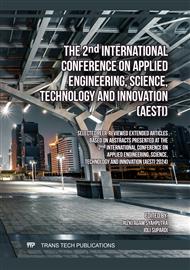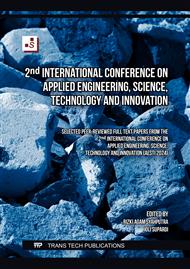[1]
I. M. de C. Tavares et al., "Storage stability of the phenolic compounds, color and antioxidant activity of jambolan juice powder obtained by foam mat drying," Food Res. Int., vol. 128, no. October 2019, p.108750, 2020.
DOI: 10.1016/j.foodres.2019.108750
Google Scholar
[2]
M. M. dos Santos et al., "Syzygium cumini leaf extract protects macrophages against the oxidized LDL-induced toxicity: A promising atheroprotective effect," Biomed. Pharmacother., vol. 142, 2021.
DOI: 10.1016/j.biopha.2020.111196
Google Scholar
[3]
N. K. Kadiyala, B. K. Mandal, S. Ranjan, and N. Dasgupta, "Bioinspired gold nanoparticles decorated reduced graphene oxide nanocomposite using Syzygium cumini seed extract: Evaluation of its biological applications," Mater. Sci. Eng. C, vol. 93, no. June, p.191–205, 2018.
DOI: 10.1016/j.msec.2018.07.075
Google Scholar
[4]
X. Sun, "Exploring metasequoia glyptostroboides leaf extract as an eco-friendly corrosion inhibitor for Q235 steel," Int. J. Electrochem. Sci., vol. 19, no. 2, p.100494, 2024.
DOI: 10.1016/j.ijoes.2024.100494
Google Scholar
[5]
S. Cherrad et al., "Cupressus arizonica fruit essential oil: A novel green inhibitor for acid corrosion of carbon steel: Cupressus arizonica fruit essential oil," Arab. J. Chem., vol. 15, no. 6, p.103849, 2022.
DOI: 10.1016/j.arabjc.2022.103849
Google Scholar
[6]
E. Masaenah et al., "Antidiabetic activity and acute toxicity of combined extract of Andrographis paniculata, Syzygium cumini, and Caesalpinia sappan," Heliyon, vol. 7, no. 12, p. e08561, 2021.
DOI: 10.1016/j.heliyon.2021.e08561
Google Scholar
[7]
L. N. Emembolu, P. E. Ohale, C. E. Onu, and N. J. Ohale, "Comparison of RSM and ANFIS modeling techniques in corrosion inhibition studies of Aspilia Africana leaf extract on mild steel and aluminium metal in acidic medium," Appl. Surf. Sci. Adv., vol. 11, no. October, p.100316, 2022.
DOI: 10.1016/j.apsadv.2022.100316
Google Scholar
[8]
F. D. FERNANDES, L. M. FERREIRA, and M. L. C. P. da SILVA, "Application of Psidium guajava L. leaf extract as a green corrosion inhibitor in biodiesel: Biofilm formation and encrustation," Appl. Surf. Sci. Adv., vol. 6, p.100185, 2021.
DOI: 10.1016/j.apsadv.2021.100185
Google Scholar
[9]
D. E. Abd-El-khalek et al., "Clove extract as a novel green inhibitor of calcium carbonate scales: morphological and adsorption studies," Int. J. Corros. Scale Inhib., vol. 11, no. 2, p.606–620, 2022.
DOI: 10.17675/2305-6894-2022-11-2-10
Google Scholar
[10]
N. Hossain, M. A. Chowdhury, A. K. M. P. Iqbal, A. K. M. F. Ahmed, and M. S. Islam, "Corrosion behavior of aluminum alloy in NaOH and Syzygium Samarangense solution for environmental sustainability," Curr. Res. Green Sustain. Chem., vol. 5, no. October 2021, p.100254, 2022.
DOI: 10.1016/j.crgsc.2021.100254
Google Scholar
[11]
H. El Hartiti et al., "Valorization of the essential oil of myrtus communis by its use as a corrosion inhibitor of mild steel in acidic medium 1.0 M HCL," Int. J. Corros. Scale Inhib., vol. 8, no. 4, p.1084–1096, 2019.
DOI: 10.17675/2305-6894-2019-8-4-16
Google Scholar
[12]
A. Singh and M. A. Quraishi, "The extract of Jamun (Syzygium cumini) seed as green corrosion inhibitor for acid media," Res. Chem. Intermed., vol. 41, no. 5, p.2901–2914, 2015.
DOI: 10.1007/s11164-013-1398-3
Google Scholar
[13]
T. Raja, S. S. S. Abuthahir, A. S. Begum, M. Lavanya, and S. Rajendran, "Corrosion inhibition performance of carbon steel in 1 N hydrochloric acid by an aqueous extract of Syzygium cumini Linn (SCL) plant leaves," Int. J. Corros. Scale Inhib., vol. 11, no. 4, p.1819–1838, 2022.
DOI: 10.17675/2305-6894-2022-11-4-26
Google Scholar
[14]
B. Mwamatope, D. Tembo, I. Chikowe, E. Kampira, and C. Nyirenda, "Total phenolic contents and antioxidant activity of Senna singueana, Melia azedarach, Moringa oleifera and Lannea discolor herbal plants," Sci. African, vol. 9, p. e00481, 2020.
DOI: 10.1016/j.sciaf.2020.e00481
Google Scholar
[15]
N. Mardani, M. Jahadi, M. Sadeghian, K. Keighobadi, and K. Khosravi-Darani, "Antimicrobial activities, phenolic and flavonoid contents, antioxidant and DNA protection of the internal and outer layers of Allium cepa L. from Iran," NFS J., vol. 31, no. March, p.93–101, 2023.
DOI: 10.1016/j.nfs.2023.03.003
Google Scholar
[16]
C. Bitwell, S. I. Sen, C. Luke, and M. K. Kakoma, "UHPLC-MS/MS phytochemical screening, polyphenolic content and antioxidant potential of Diplorhynchus condylocarpon (Müll.Arg.) Pichon (Apocynaceae), a medicinal plant," Sci. African, vol. 20, 2023.
DOI: 10.1016/j.sciaf.2023.e01712
Google Scholar
[17]
E. Asante-Kwatia et al., "Amphimas pterocarpoides harms.: An Evaluation of flavonoid and phenolic contents, wound healing, anthelmintic and antioxidant activities of the leaves and stem bark," Heliyon, vol. 7, no. 11, p. e08261, 2021.
DOI: 10.1016/j.heliyon.2021.e08261
Google Scholar
[18]
T. Sithuba et al., "Corrosion inhibitory potential of selected flavonoid derivatives: Electrochemical, molecular⋅⋅⋅Zn surface interactions and quantum chemical approaches," Results Eng., vol. 16, no. July, 2022.
DOI: 10.1016/j.rineng.2022.100694
Google Scholar
[19]
O. A. Akinbulumo, O. J. Odejobi, and E. L. Odekanle, "Thermodynamics and adsorption study of the corrosion inhibition of mild steel by Euphorbia heterophylla L. extract in 1.5 M HCl," Results Mater., vol. 5, no. November 2019, p.100074, 2020.
DOI: 10.1016/j.rinma.2020.100074
Google Scholar
[20]
P. T. Thompson, V. E. Boamah, and M. Badu, "In-vitro antioxidant, antimicrobial and phytochemical properties of extracts from the pulp and seeds of the African baobab fruit (Adansonia digitata L.)," Heliyon, vol. 10, no. 8, p. e29660, 2024.
DOI: 10.1016/j.heliyon.2024.e29660
Google Scholar
[21]
G. K. Shamnamol, P. Rugma, S. John, and J. Mary Jacob, "Unraveling the synergistic effect of cationic and anionic salt on the corrosion inhibition performance of Garcinia gummi-gutta leaf extract against mild steel in HCl medium," Results Chem., vol. 5, no. December 2022, p.100728, 2023.
DOI: 10.1016/j.rechem.2022.100728
Google Scholar
[22]
P. O. Oghenerukevwe, C. I. Ajuwa, O. D. Samuel, and T. F. Adepoju, "Carica papaya leaf extract (CPLE) as green corrosion inhibitor for AISI 4140 steel in 15% hydrochloric acid medium," Case Stud. Chem. Environ. Eng., vol. 8, no. September, p.100479, 2023.
DOI: 10.1016/j.cscee.2023.100479
Google Scholar
[23]
Hidayat RHayati L, "Eureka Herba Indonesia," Eureka Herba Indones., vol. 1, no. 1, p.1–5, 2020.
Google Scholar
[24]
E. D. Teodor, O. Ungureanu, F. Gatea, and G. L. Radu, "The Potential of Flavonoids and Tannins from Medicinal Plants as Anticancer Agents," Anticancer. Agents Med. Chem., vol. 20, no. 18, p.2216–2227, 2020.
DOI: 10.2174/1871520620666200516150829
Google Scholar
[25]
U. Mamudu, M. S. Alnarabiji, and R. C. Lim, "Adsorption isotherm and molecular modeling of phytoconstituents from Dillenia suffruticosa leaves for corrosion inhibition of mild steel in 1.0 M hydrochloric acid solution," Results in Surfaces and Interfaces, vol. 13, no. September, p.100145, 2023.
DOI: 10.1016/j.rsurfi.2023.100145
Google Scholar
[26]
H. Mobtaker, M. Azadi, and M. Rassouli, "The corrosion inhibition of carbon steel in 1 M HCl solution by Oestrus ovis larvae extract as a new bio–inhibitor," Heliyon, vol. 8, no. 12, p. e12297, 2022.
DOI: 10.1016/j.heliyon.2022.e12297
Google Scholar
[27]
D. B. Left, M. Zertoubi, S. Khoudali, and M. Azzi, "New application of chamaerops humilis l. Extract as a green corrosion inhibitor for reinforcement steel in a simulated carbonated concrete pore solution," Port. Electrochim. Acta, vol. 36, no. 4, p.249–257, 2018.
DOI: 10.4152/pea.201804249
Google Scholar
[28]
A. I. Ikeuba et al., "Experimental and theoretical evaluation of Aspirin as a green corrosion inhibitor for mild steel in acidic medium," Results Chem., vol. 4, no. October, p.100543, 2022.
DOI: 10.1016/j.rechem.2022.100543
Google Scholar
[29]
F. E. Abeng et al., "Millettia aboensis leaves extract as eco-friendly corrosion inhibitor for mild steel in acidizing solution: From experimental to molecular level prediction," Results Eng., vol. 24, no. September, p.102950, 2024.
DOI: 10.1016/j.rineng.2024.102950
Google Scholar
[30]
M. Akbari Shahmirzadi and M. Azadi, "A new study on the corrosion inhibition mechanism of green walnut husk extract as an agricultural waste for steel protection in HCl solution," Heliyon, vol. 10, no. 9, p. e29962, 2024.
DOI: 10.1016/j.heliyon.2024.e29962
Google Scholar



